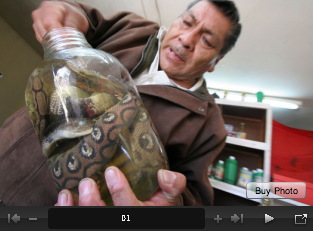<==VIDEO (Go to original story and Click on Video)
The assistant of Emilio Cusi, Vice Minister of traditional medicine, prepares to use a liquid in which a snake is macerating, in the barrio of El Alto, in the outskirts of the capital city of La Paz, Bolivia. BORIS HEGER / FOR MIAMI HERALD
Bolivia embraces traditional healers
Bolivia is giving old treatments a try by expanding public health to include indigenous remedies.
September 26, 2008 - The Miami Herald
BY ANNIE MURPHY, Special to The Miami Herald
EL ALTO, Bolivia -- When Sabino Quento was involved in a serious car accident, the hospital was the last place he thought to seek treatment for his broken bones and nerve damage.
Instead, he went to Emiliano Cusi, a traditional healer and Bolivia's new vice minister of traditional medicine. Cusi was appointed by President Evo Morales as part of a plan to expand public health to include indigenous healing.
"The hospital isn't really an option," Quento said. "I don't have the financial resources, and frankly, we hear strange things about doctors."
Quento is from the highlands of Bolivia, where indigenous communities have a wary relationship with Western medicine. Like the majority of Bolivians, Quento has neither health insurance nor the ability to pay out of pocket, and grew up using traditional healing to treat illnesses. He sees hospitals as a dubious last resort.
So Quento first sought out Cusi and Antonio Condorichi, another practitioner in the city of El Alto's traditional healing district.
The bustling area consists of little more than a dirt track running along a precipice 1,500 feet above the capital of La Paz. At dawn, herbalists and shamans stand before their storefronts coaxing alive fires to warm their morning coffee, and to aid in the day's rituals.
As business gets under way, customers approach healers for services that range from headache-soothing poultices to llama sacrifices for health, a good harvest, love or just luck.
Since Morales, an Aymara Indian, became president in 2006, his policies have focused on this country's indigenous majority. More than 60 percent of Bolivia's nine million citizens are indigenous; a similar number live below the poverty line.
Morales' creative approach to health has meant providing free care to citizens under 22 and pregnant women, importing more than 1,500 Cuban medical personnel -- and institutionalizing natural healing practices as part of the public health system formerly dominated by Western-styled medicine.
REGISTRY IN WORKS
Now Cusi is trying to find the spaces to promote indigenous healing.
The new vice ministry plans to train and register all traditional healers, creating a national directory of alternative practitioners. His favorite project is something he calls "cottage pharmacies" -- networks of herbalists trained to make natural treatments in their homes, for distribution in nearby hospitals.
Cusi believes that building respect for indigenous traditions and gradually incorporating them into a more Western model benefits both sides.
"We've always had a strong relationship with nature," Cusi says. "Now our goal is to organize and promote it as part of public health."
Cusi, an indigenous healer for more than 20 years, keeps his practice with friend Antonio Condorichi on weekends. Together, Cusi and Condorichi treated Quento after his car accident, and on a recent Thursday morning they met with their patient.
"To mend his broken foot, for example, we began with these vipers," said Condorichi, motioning to a jar of dead snakes curing on his desk. "Then we took lizard, some dog's blood, and mixed it with a variety of herbs. We ground it into a pomade and placed it on the patient's foot."
NATURAL REMEDIES
While Western-trained physicians aren't writing prescriptions like that one, not all treatments are so exotic. At the Cusi and Condorichi practice, an ordinary inflammation warrants a chamomile bath; an upset stomach, coca tea.
Dr. Eduardo Moreno, a general practitioner in La Paz, says he also uses tea brewed from the controversial coca leaf for stomach problems.
"Indigenous medicine doesn't exist just because these communities can't afford hospitals," Moreno said. "Many of these remedies work, and Western medicine often borrows from indigenous tradition."
Moreno makes it clear he feels Western medicine is more advanced than its indigenous counterpart.
But, he says, Bolivia should use this valuable opportunity to combine the two practices.
"Racism against indigenous people is common here, and that has also applied to medical scenarios," Cusi said. "It made many of us afraid to seek treatment with a Western doctor. And the truth is there are reasons for visiting both."
ESTABLISHING TRUST
Moreno says that indigenous patients often arrive at the hospital accompanied by their healer or shaman, who give comfort as well as valuable interpretations from Indian languages, and also provide detailed descriptions of symptoms.
"We find this very helpful in establishing trust between doctor and patient," Moreno said. "In the end, that's the most important part of an effective treatment."
Four months after his accident, Quento's healers deemed him ready to play soccer again. Quento says he's grateful just to walk.
"Maybe eventually I'll visit a hospital to fix this up," he said, motioning to his nose, which was broken in the accident and never set straight.
"But I'm alive and well, and for that I have traditional medicine to thank."
